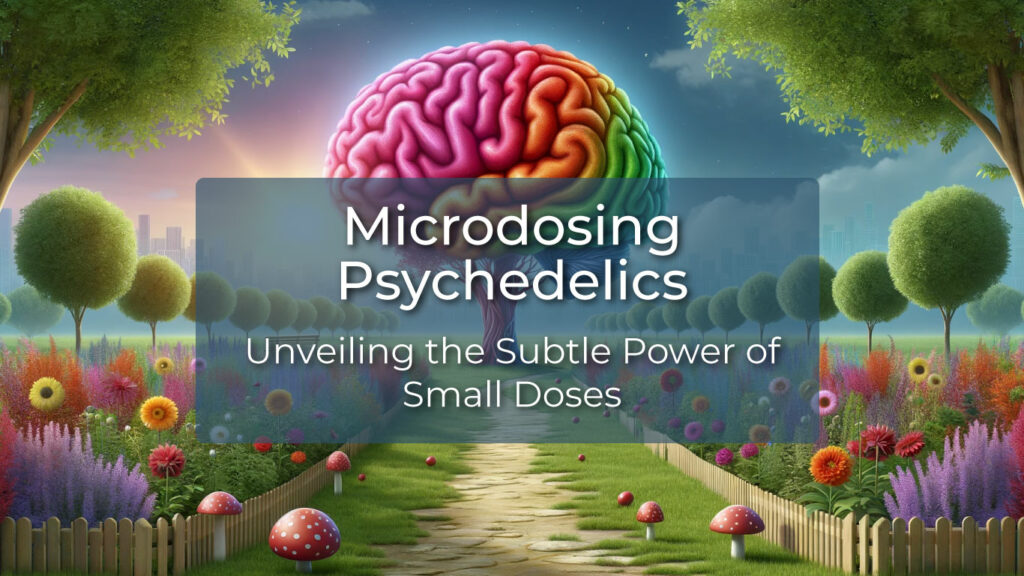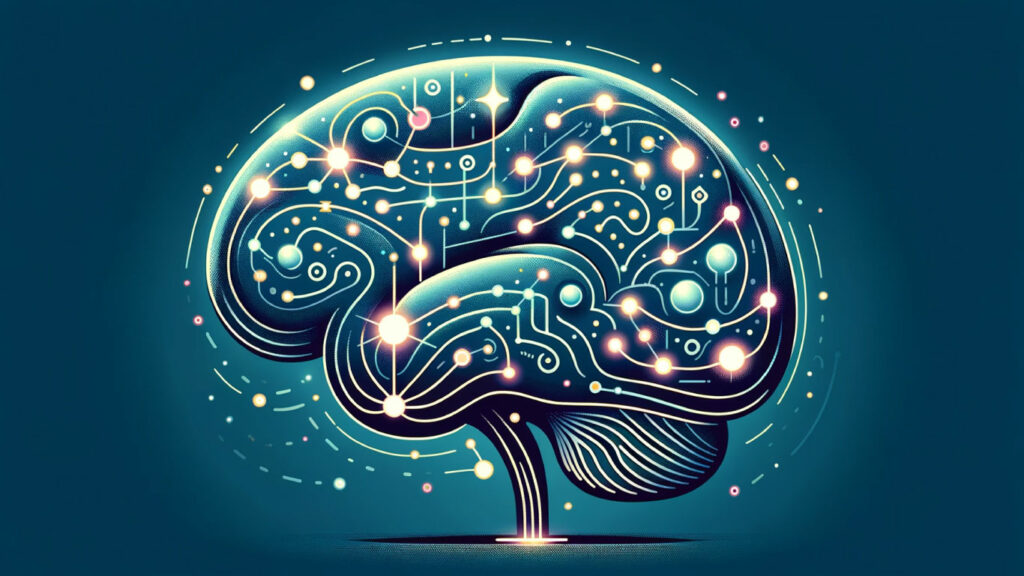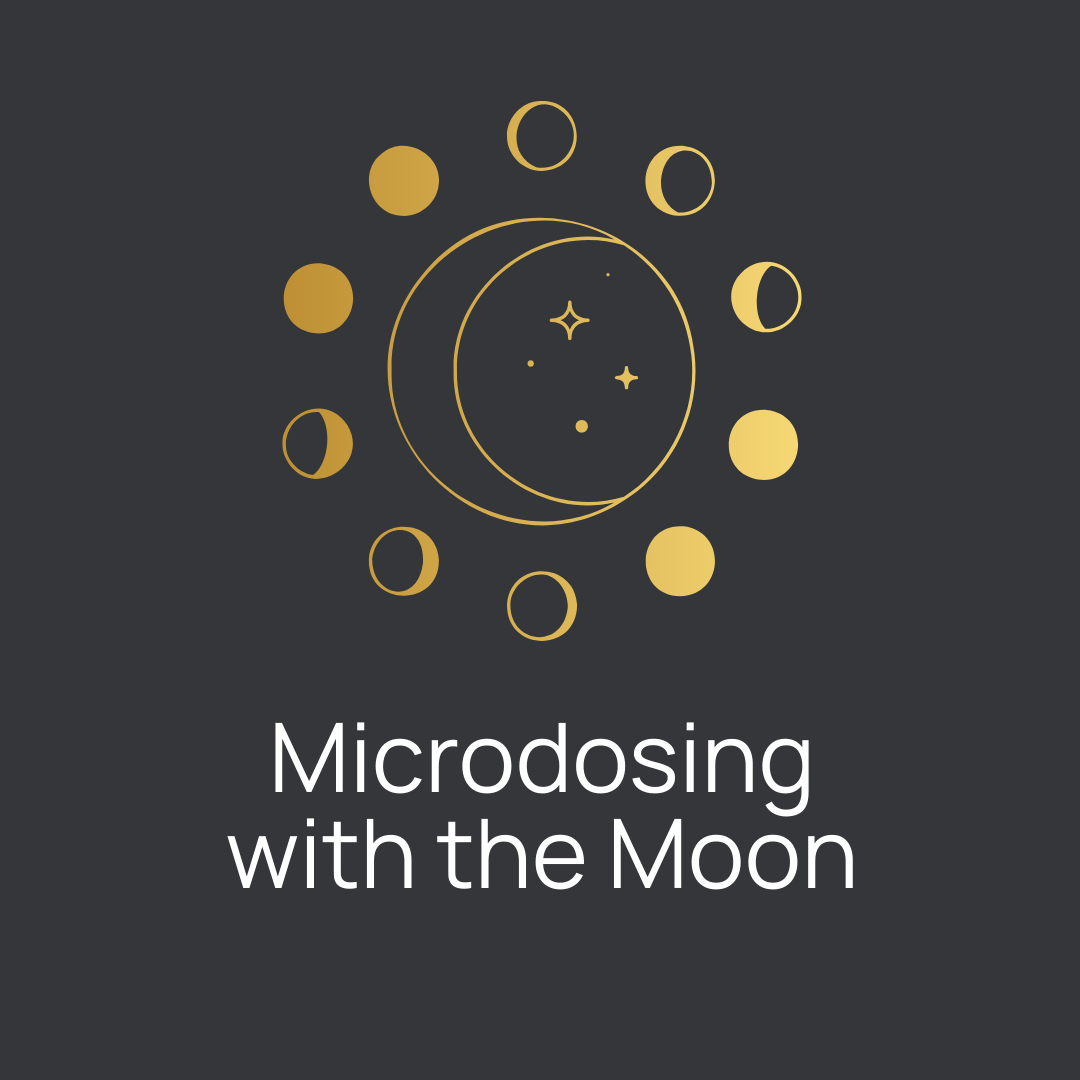Microdosing Psychedelics: Unveiling the Subtle Power of Small Doses

Exploring Microdosing: A Gentle Introduction to Psychedelics
Imagine tiny changes creating profound transformations. This is the essence of microdosing psychedelics, a practice that's gaining curiosity and attention far beyond the circles of experienced psychedelic users. For many, the idea of using psychedelics brings a mix of intrigue and hesitation. Anti-drug campaigns of long ago painted a picture in the minds of many young people that is hard to break free from. And then there are the legal concerns. Yet, despite these hurdles, microdosing invites an exploration in a way that's gentle, controlled, and deeply personal.
Microdosing involves taking very small amounts of substances like LSD or psilocybin mushrooms so the intense experiences associated with full doses don't happen. These “micro” doses are just enough to nudge the mind and body in subtle, often beneficial ways. Think of it as adjusting a lens on how you see and interact with the world, enhancing everything from creativity and focus to emotional balance and resilience, all without stepping too far from your comfort zone. People are able to go about their day. A microdose does not induce intoxication, hallucinating, or seeing visual disturbances (sub-perceptual).
This journey into microdosing is not about radical changes but about opening doors to new ways of thinking and feeling that are as safe. Whether you're drawn by a desire to expand your creativity, find new strategies for well-being, or simply satisfy your curiosity about psychedelics in a cautious and informed manner, you're in the right place. Let's embark on this exploration together, with open minds and a spirit of discovery, to understand how small doses can lead to significant insights.
Understanding the Basics of Microdosing
At the heart of microdosing is a simple concept: taking a tiny fraction of what's considered a recreational dose of psychedelics to explore their potential benefits without being intoxicated or hallucinating. This practice stands on the premise that these small doses, often one-tenth to one-twentieth of a typical dose, have an impact on your brain, body, and mind without inducing the intense psychedelic experiences associated with higher doses.
Microdosing has caught the attention of a wide audience, from those in creative fields seeking inspiration to professionals looking for a productivity boost, and individuals interested in personal development or alternative ways to manage mental health challenges. The substances most commonly used for microdosing include LSD (lysergic acid diethylamide) and psilocybin, the active compound in magic mushrooms, however there are many other substances being researched and used throughout history. The approach and substances can vary widely, reflecting the personal nature of the practice.
The protocols for microdosing vary. Check out the Microdosing Institute for tried and true protocols that work. When I have done my own microdosing regimes and when I have worked with others on creating one for themselves, I follow a two days a week protocol. There are a couple of reasons for this:
- It fits my lifestyle and many of my clients' lifestyles better. My schedule is not the same day after day but it is relatively the same week after week. For people that have typical M-F jobs with a set schedule this protocol allows them to adhere without worrying about being inconsistent (especially my ADHD folks that have a tendency to lose interest when the newness of whatever they are doing wears off).
- More importantly, having space between microdosing days allows individuals to observe and integrate the subtle changes they experience and take advantage of the neuroplasticity benefits of microdosing psychedelics.
The neuroplastic effect of microdosing can be a key player in shaping our brains. We can use tiny doses to help our brains to adapt and grow, making us more flexible in how we think, feel, and respond to the world. It's not just about the immediate effects but how microdosing could be tweaking the wiring under the hood.

Neuroplasticity: Understanding the Brain's Flexibility
At its core, neuroplasticity is about the brain's amazing ability to change and adapt. It's at work when we learn a new skill, change a habit, or adjust to new circumstances. We are literally reshaping and rewiring our brains with every experience - new or old. This capacity for change stays with us our entire lives.
The beauty of neuroplasticity is evident in everyday life. It's easy to understand when we're thinking about new experiences such as learning to play an instrument, picking up a new language, or adapting to a change in a routine. Our brains are constantly forming new connections when you're doing something new but the brain also strengthens existing ones when you repeat behaviors and thoughts. Microdosing can play a role in this process, acting as a catalyst for personal development and mental health management. It offers a tool for those looking to smooth out the process of change, making it easier to adopt new habits and perspectives.
By taking tiny, non-intoxicating doses of substances like LSD or psilocybin, we can gently encourage our brain's neural pathways to grow and evolve. It's akin to fine-tuning the mind's wiring, enhancing how we think, feel, and perceive our environment without the overwhelming effects of a full psychedelic experience.
Research into psychedelics has shown that they can stimulate the brain in ways that promote neuroplasticity. This means that microdosing could help create and reinforce neural connections, making our brains more adaptable and flexible. For anyone looking to break free from old patterns or explore new ways of thinking, the implications of this are profound.
The potential of microdosing to enhance neuroplasticity goes beyond temporary, subtle shifts in mood or creativity while the effects of the microdose are active. It suggests a pathway to lasting change, contributing to long-term improvements in how we approach life's challenges and pursue personal growth.
People suffering from PTSD, such as veterans, often struggle to find solutions that create lasting change. Traditional treatments have often not been able to help alter the deep-rooted patterns that PTSD imprints on the brain. This is where the nuanced benefits of microdosing have been showing long-lasting effects when other treatment options have failed. By harnessing the potential of neuroplasticity, microdosing offers a glimmer of hope for reshaping those patterns in a more constructive and healing manner. The gentle nudging of neural pathways through microdosing can facilitate a sustainable recovery, opening doors to new ways of coping that were previously inaccessible, and ultimately having a profound, long-lasting effect.
The transformative power of microdosing, rooted in its ability to enhance neuroplasticity, is not only for people with treatment resistant mental health conditions. In fact there are countless people that have reported having positive effects from microdosing for a wide range of conditions from cluster headaches to ADHD.
As we continue to delve into the mysteries of the brain and the potential of psychedelics, microdosing stands out as a promising tool for not only those seeking to overcome mental and physical health challenges, but also for anyone eager to explore the depths of their own minds and unlock new realms of possibility.
As we navigate the intricacies of neuroplasticity and the nuances of microdosing, we are reminded of our inherent ability to adapt, grow, and transform our lives from within. Microdosing psychedelics, with its subtle yet impactful influence on our brain's wiring, offers a unique opportunity to engage with this change in a deliberate and mindful way.
The Individuality of Psychedelic Experiences
Every person's brain is a unique landscape, with its own patterns of connectivity and activity. Within this landscape, seven major brain networks play crucial roles in everything from our thought processes to how we perceive the world around us. One of these, the Default Mode Network (DMN), is particularly notable for its involvement in self-referential thoughts and the "mind wandering" that happens when we're not focused on the outside world.
Research shows that psychedelics shift activity from the DMN to other networks, resulting in a different distribution of energy directed at the different brain networks. It is this shift that creates the changes in perception, thought, and emotion. When people hear about (or experience) a large psychedelic dose experience, these changes in perception are quite noticeable allowing for a more expansive awareness of things the brain may filter out normally.
The effects of psychedelics are not one-size-fits-all; they can vary significantly from one substance to another and from one individual to the next. For example, while LSD might enhance sensory perception and emotional openness, psilocybin could lead to profound spiritual experiences or deep introspective insights. This variance underscores the deeply personal nature of psychedelic experiences, influenced by both the biochemical makeup of the substance and the unique neural architecture of the individual.
Anecdotal evidence plays a vital role in our understanding of these individual experiences. While controlled studies offer valuable insights into the general effects of psychedelics, personal stories and subjective reports illuminate the vast spectrum of possible outcomes. These narratives help to paint a fuller picture of what microdosing can do, highlighting the diverse ways in which these substances can impact mental health, creativity, and personal growth.
The individuality of psychedelic experiences is a reminder of the complexity of the human mind and the potential for psychedelics to act as tools for exploration and transformation. Microdosing offers a safer, more controlled way to explore psychedelics' transformative effects. This approach lets individuals experience the benefits—like increased creativity and emotional insight—without the overwhelming intensity of a full dose. It's about fine-tuning the experience to the individual's needs, providing a gentle introduction to new ways of thinking and perceiving.
By adjusting doses, microdosing respects each person's unique mental landscape, minimizing risks while unlocking potential for positive change. It's an accessible path for those curious about the cognitive and emotional shifts psychedelics can provoke, without stepping too far from comfort zones.
In essence, microdosing bridges the gap between deep psychedelic exploration and everyday mental health and personal growth. It highlights the diverse needs of our brains, advocating for a personalized approach to exploration and well-being.
Microdosing and Neurodivergence: Navigating Diverse Brain Landscapes
Neurodivergence represents the myriad of ways brains can function differently from the so-called neurotypical norms. Conditions like ADHD are not characterized by a lack of ability, but by a distinct pattern of energy allocation within the brain. This unique wiring can lead to remarkable strengths, such as heightened creativity and the ability to think outside the box. However, conventional environments often aren't designed to accommodate these differences, leading to challenges that can significantly tax neurodivergent individuals' mental and emotional resources.
For those with ADHD and similar neurodivergent conditions, staying in the Default Mode Network (DMN) — a mental state often associated with rumination, anxiety, and daydreaming — can be particularly draining. This constant expenditure of energy on defense mechanisms can leave little energy for tasks requiring executive function, such as planning, focusing, and managing emotions.
Microdosing psychedelics presents a promising avenue for alleviating some of these energetic demands. By lowering the threshold required to shift from the DMN to more executive modes of thinking, microdosing can help neurodivergent individuals harness their natural strengths without the overwhelming stress and fatigue. The potential for increased neuroplasticity through microdosing means not just temporary relief but the development of more resilient neural pathways, facilitating easier transitions into states of higher cognitive functioning and emotional processing.
This shift doesn't just mitigate the challenges of neurodivergence; it leverages its assets. The enhanced neuroplasticity encouraged by microdosing can empower neurodivergent individuals to rewire their brains in ways that support more balanced and effective engagement with the world. It opens up a pathway to not only cope with but thrive in environments designed for neurotypical minds.
Microdosing is a tool that can be used for better integration and function within a world that often overlooks the unique needs of neurodivergent minds. By providing a way to reduce stress and enhance focus, microdosing can help preserve the innate advantages of neurodivergent thinking while mitigating its associated energy costs. In doing so, it champions a more inclusive understanding of mental diversity, acknowledging the value of all cognitive styles in enriching our collective human experience.
Stress, Trauma, and Healing in Modern Society
In today's fast-paced world, stress has become a universal companion, and traumatic experiences are, unfortunately, all too common. It's hard to find someone whose life remains untouched by stress or the echoes of past trauma. These experiences shape us in profound ways, influencing not just our mental health but our physical well-being too.
When we delve into the connections between our minds, bodies, and the environments we navigate, a critical truth emerges: unresolved stress is the silent architect of discomfort and disease. It's the thread that weaves through various mental and physical health challenges, often lying at their core.
The Default Mode Network (DMN) plays a significant role in this narrative. Known for its activity during mind-wandering and self-referential thoughts, the DMN is also linked to the rumination often associated with stress and trauma. When we're caught in a loop of stressful thoughts or traumatic memories, the DMN is in overdrive, reinforcing patterns that keep us tethered to our past and apprehensive about our future.
Emerging research underscores the impact of stress on healing and recovery. Stress doesn't just hinder our mental health; it can delay physical healing, disrupt immune function, and exacerbate conditions from heart disease to diabetes. In essence, managing stress isn't just about feeling better mentally; it's about fostering a healthier, more resilient body.
The holistic benefits of microdosing—reducing stress while increasing neuroplasticity—highlight its potential as a complementary approach in the broader landscape of health and wellness. This approach aligns with the understanding that true healing encompasses both the psychological and physiological, offering a more comprehensive path toward well-being.
Microdosing serves not only as a method to reduce stress but also as a doorway to deeper self-connection and spirituality. By alleviating the burdens of stress, microdosing clears a path toward pleasure and joy, allowing us to reorient our focus towards what truly enriches our lives. This shift from a pain-avoidance strategy to one that embraces the pursuit of joy can be transformative, retraining our brains to seek out and cherish the moments that bring us genuine happiness and fulfillment.
In embracing microdosing as part of a comprehensive strategy for dealing with stress and trauma, we not only open new avenues for healing but also rediscover the power of joy as a fundamental component of health. This journey invites a profound exploration of how altering our brain's response to stress can lead to significant changes in our overall health and well-being, bridging the gap between our psychological state, physical health, and spiritual fulfillment.
The Transformative Power of Microdosing
It turns out, those tiny doses pack a punch, opening doors to understanding ourselves and how we heal in ways we might not have expected. Microdosing is an invitation to discover unexpected paths to joy and well-being amidst the hustle of everyday life.
Healing isn't only about fixing what's broken. It's also about embracing the journey, finding joy in the small moments, and appreciating the little things that life throws our way.
Here's to the small shifts that lead to big changes. To healing, to happiness, and to the beauty of being human.
References:
Calder, A.E., Hasler, G. Towards an understanding of psychedelic-induced neuroplasticity. Neuropsychopharmacol. 48, 104–112 (2023). https://doi.org/10.1038/s41386-022-01389-z
Cameron, L. P., Benson, C. J., DeFelice, B. C., Fiehn, O., & Olson, D. E. (2019). Chronic, Intermittent Microdoses of the Psychedelic N,N-Dimethyltryptamine (DMT) Produce Positive Effects on Mood and Anxiety in Rodents. ACS chemical neuroscience, 10(7), 3261–3270. https://doi.org/10.1021/acschemneuro.8b00692
Vanderijst, L., Hever, F., Buot, A. et al. Psilocybin-assisted therapy for severe alcohol use disorder: protocol for a double-blind, randomized, placebo-controlled, 7-month parallel-group phase II superiority trial. BMC Psychiatry 24, 77 (2024). https://doi.org/10.1186/s12888-024-05502-y
Allen, J., Dames, S.S., Foldi, C.J. et al. Psychedelics for acquired brain injury: a review of molecular mechanisms and therapeutic potential. Mol Psychiatry (2024). https://doi.org/10.1038/s41380-023-02360-0
Hasler G. (2020). Toward specific ways to combine ketamine and psychotherapy in treating depression. CNS spectrums, 25(3), 445–447. https://doi.org/10.1017/S1092852919001007
Griffiths, R. R., Johnson, M. W., Carducci, M. A., Umbricht, A., Richards, W. A., Richards, B. D., Cosimano, M. P., & Klinedinst, M. A. (2016). Psilocybin produces substantial and sustained decreases in depression and anxiety in patients with life-threatening cancer: A randomized double-blind trial. Journal of psychopharmacology (Oxford, England), 30(12), 1181–1197. https://doi.org/10.1177/0269881116675513
Ross, S., Bossis, A., Guss, J., Agin-Liebes, G., Malone, T., Cohen, B., Mennenga, S. E., Belser, A., Kalliontzi, K., Babb, J., Su, Z., Corby, P., & Schmidt, B. L. (2016). Rapid and sustained symptom reduction following psilocybin treatment for anxiety and depression in patients with life-threatening cancer: a randomized controlled trial. Journal of psychopharmacology (Oxford, England), 30(12), 1165–1180. https://doi.org/10.1177/0269881116675512
Singleton, S.P., Luppi, A.I., Carhart-Harris, R.L. et al. Receptor-informed network control theory links LSD and psilocybin to a flattening of the brain’s control energy landscape. Nat Commun 13, 5812 (2022). https://doi.org/10.1038/s41467-022-33578-1





